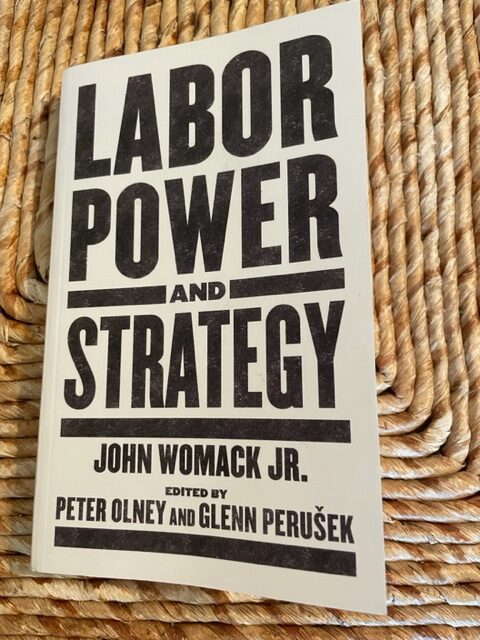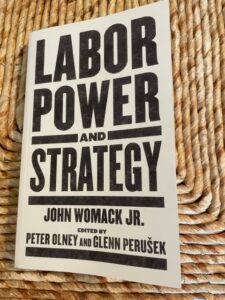BY STAS MARGARONIS
A new book, authored by historian John Womack, “Labor Power and Strategy” edited by Peter Olney and Glen Perusek, focuses on the need for U.S. workers to organize unions in strategic industries and discusses wins and losses experienced by union organizers.
Two union organizers discuss issues impacting workers in warehousing and the railroads:
In the book’s Introduction Peter Olney, the retired organizing director for the International Longshore and Warehouse Union (ILWU) discusses his efforts to persuade the ILWU to replicate its “March Inland.” At that time, the ILWU had won union recognition for dock workers during the 1934 West Coast Longshore Strike. The union then sought to organize warehouse workers located near the docks so that union representation would include strategic elements of the maritime-based supply chain.
In 2004, Olney related that while the ILWU did support organizing warehouse workers including those at Rite Aid but he was unable to win full acceptance for a major organizing campaign from the ILWU leadership.
As a result of declining U.S. union membership, Olney was searching for a new union organizing strategy and described a dialogue that developed between himself and historian John Womack that forms the basis for the book.
Womack is the author of “Zapata and the Mexican Revolution.” The history traces the rise of Emiliano Zapata (1879-1919) as a peasant leader who became a national champion for agrarian reform during the Mexican Revolution (1910-1920).
Olney hopes the “Labor Power” book will inspire union organizers.
At an August presentation held at Berkeley California, Olney discussed the book and the challenges of organizing workers in the United States
RAILROAD SAFETY
At the Berkeley presentation, Olney was joined by Carey Dall, the former organizing director for railroad maintenance workers represented by the Brotherhood of Maintenance of Way, a division of the International Brotherhood of Teamsters.
In the book, Dall writes that organizing strategic industries is difficult when “rail and longshore unions do not collaborate.”
In the discussion, Dall said that legislation governing railroad workers does not protect union workers from recent labor cut backs instituted by a number of major railroads based on Precision Scheduled Railroading (PSR). This is a practice that place profitability ahead of safety, he said. These cutbacks contribute to shortfalls in railroad track maintenance resulting in train derailments, he said.
Railroads, who apply PSR, say that PSR reduces costs and streamlines operations.
Last February, the derailment issue came to national attention in East Palestine, Ohio when a 50 car Norfolk Southern train was derailed causing a fire and release of hazardous chemicals.
Dall said that weak labor laws undermine the ability of rail unions to fight for safety for communities like East Palestine as well as for railroad workers.
Reflecting Dall’s frustration with reforming railroad operations was a July Associated Press report stating that railroads are opposing efforts by the State of Ohio requiring larger railroad crew sizes to prevent a repeat of the East Palestine derailment:
“The railroad industry has sued to block a new minimum crew-size requirement that Ohio imposed after a fiery train derailment in East Palestine in February.
The new rule was part of a $13.5 billion state transportation budget that Republican Ohio Governor Mike DeWine signed in March. It mandated a two-person crew for freight trains and required that the wayside detectors used to help spot problems be installed in shorter intervals of 10 to 15 miles … with oversight from the Ohio Department of Transportation and the Public Utilities Commission of Ohio, among other provisions.”[1]
The derailment issue reflects a means by which railroad safety can become a bi-partisan collaboration for railroad unions, shippers and railroads to support. Ohio’s efforts to increase rail crew sizes and provide more safety investments in rail operations should help reduce the possibility of derailments if strategic alliances are built to support reform.
PMA ILWU COLLABORATION
A successful case of labor management collaboration that helped both workers and employers, that is not described in the ‘Labor Power’ book, is the 1960 collaboration between the ILWU and Pacific Maritime Association (PMA) in support of mechanization of cargo-handling at U.S. Pacific Coast ports.
In 1960, under the leadership of its founding president Harry Bridges the International Longshore and Warehouse Union agreed to the Mechanization and Modernization Agreement (M&M) that eliminated old work rules and allowed for more mechanization of cargo-handling operations. The agreement reflected a collaboration between Paul St Sure, president Pacific Maritime Association and Bridges in which the labor and management worked together to make Pacific Coast ports more productive and re-engineered terminal operations for new container handling operations that were then just beginning. [2]
In contrast, the International Longshoremen’s Association (ILA), which represented longshore workers from Maine to Texas resisted mechanization. The result was that East and Gulf Coast ports represented by the ILA were slow to adopt mechanization and fell behind West Coast ports.
ILWU PUSHES FOR INVESTMENT IN MECHANIZATION
In 1965 in one of the great ironies of U.S. labor-management relations, the ILWU forced West Coast stevedores to spend more money on mechanization. Some stevedores refused to invest in new equipment and sought to use the M&M agreement to impose higher work loads on longshore workers. This prompted the ILWU to file grievances resulting in an arbitration finding that required stevedoring companies to spend more money on forklifts and winches, according to a history of containerization, “The Box,” written by Marc Levinson, a former economics editor for the London-based Economist and former editorial director for the Journal of Commerce.
Bridges was quoted as telling employers in contract negotiations “We intend to push to make the addition of machines compulsory.”[3]
By 1966, West Coast shipping interests had paid $29 million into early retirement and other benefits to ILWU members marking a rare incident where labor and management shared in the benefits of mechanization.
However, gains to shipping interests far outpaced those benefits accorded to longshore workers: they amounted to twelves times those payments, Levinson noted.[4]
By 1965, Harry Bridges, the labor radical and Marxist who led the establishment of the ILWU as a result of the 1934 West Coast Longshore Strike, had transitioned to a role in which he operated as part labor leader and part industrialist.
The result would be prosperity and growth for West Coast ports and dockworkers that would continue for over sixty years.
Perhaps there are some lessons here for today’s union organizers
FOOTNOTES
[1] https://apnews.com/article/rail-safety-ohio-crew-size-derailment-lawsuit-429df55468cc112d7057d4dd1dcf5322
[2] Marc Levinson, “The Box: How the Shipping Container Made the World Smaller and the World Economy Bigger” (2005), pp114-117
[3] Ibid, p117
[4] Ibid, p.117


